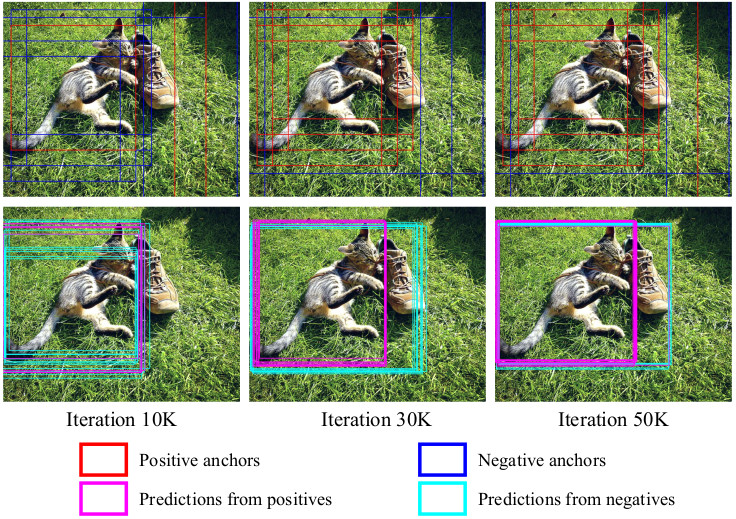By Kang Kim and Hee Seok Lee.
This is a PyTorch implementation of the paper Probabilistic Anchor Assignment with IoU Prediction for Object Detection (paper link), based on ATSS and maskrcnn-benchmark.
Now the code supports PyTorch 1.6.
PAA is available at mmdetection. Many thanks to @jshilong for the great work!
In object detection, determining which anchors to assign as positive or negative samples, known as anchor assignment, has been revealed as a core procedure that can significantly affect a model's performance. In this paper we propose a novel anchor assignment strategy that adaptively separates anchors into positive and negative samples for a ground truth bounding box according to the model's learning status such that it is able to reason about the separation in a probabilistic manner. To do so we first calculate the scores of anchors conditioned on the model and fit a probability distribution to these scores. The model is then trained with anchors separated into positive and negative samples according to their probabilities. Moreover, we investigate the gap between the training and testing objectives and propose to predict the Intersection-over-Unions of detected boxes as a measure of localization quality to reduce the discrepancy.
Please check INSTALL.md for installation instructions.
The inference command line on coco minival split:
python tools/test_net.py \
--config-file configs/paa/paa_R_50_FPN_1x.yaml \
MODEL.WEIGHT [/path/to/weight] \
TEST.IMS_PER_BATCH 4
Please note that:
- If your model's name is different, please replace
PAA_R_50_FPN_1x.pthwith your own. - If you enounter out-of-memory error, please try to reduce
TEST.IMS_PER_BATCHto 1. - If you want to evaluate a different model, please change
--config-fileto its config file (in configs/paa) andMODEL.WEIGHTto its weights file.
We provide the performance of the following trained models. All models are trained with the configuration same as ATSS.
| Model | Multi-scale training | Multi-scale testing | AP (minival) | AP (test-dev) | Checkpoint |
|---|---|---|---|---|---|
| PAA_R_50_FPN_1x | No | No | 40.4 | - | - |
| PAA_R_50_FPN_1.5x | No | No | 41.1 | 41.2 | link |
| PAA_R_101_FPN_2x | Yes | No | 44.6 | 44.9 | link |
| PAA_dcnv2_R_101_FPN_2x | Yes | No | 47.1 | 47.4 | link |
| PAA_X_101_64x4d_FPN_2x | Yes | No | 46.4 | 46.8 | link |
| PAA_dcnv2_X_101_64x4d_FPN_2x | Yes | No | 48.8 | 49.2 | link |
| PAA_dcnv2_X_101_32x8d_FPN_2x | Yes | No | 48.9 | 49.0 | - |
| PAA_dcnv2_X_152_32x8d_FPN_2x | Yes | No | 50.5 | 50.8 | link |
| PAA_dcnv2_X_101_64x4d_FPN_2x | Yes | Yes | 51.3 | 51.6 | link |
| PAA_dcnv2_X_101_32x8d_FPN_2x | Yes | Yes | 51.2 | 51.4 | - |
| PAA_dcnv2_X_152_32x8d_FPN_2x | Yes | Yes | 53.0 | 53.5 | link |
[1] 1x , 1.5x and 2x mean the model is trained for 90K, 135K and 180K iterations, respectively.
[2] All results are obtained with a single model.
[3] dcnv2 denotes deformable convolutional networks v2. Note that for ResNet based models, we apply deformable convolutions from stage c3 to c5 in backbones. For ResNeXt based models only stage c4 and c5 use deformable convolutions. All dcnv2 models use deformable convolutions in the last layer of detector towers.
[4] Please use TEST.BBOX_AUG.ENABLED True to enable multi-scale testing.
We also provide experimental results that apply PAA to Region Proposal Network of Faster R-CNN. Code is available at PAA_Faster-RCNN.
| Model | AP (minival) | AP50 | AP75 | APs | APm | APl |
|---|---|---|---|---|---|---|
| Faster_R_50_FPN_1x | 37.989 | 58.810 | 41.314 | 22.361 | 41.522 | 49.584 |
| Faster_R_50_FPN_PAA_1x | 39.292 | 60.019 | 42.567 | 22.650 | 43.170 | 51.875 |
The following command line will train PAA_R_50_FPN_1x on 8 GPUs with Synchronous Stochastic Gradient Descent (SGD):
python -m torch.distributed.launch \
--nproc_per_node=8 \
--master_port=$((RANDOM + 10000)) \
tools/train_net.py \
--config-file configs/paa/paa_R_50_FPN_1x.yaml \
DATALOADER.NUM_WORKERS 2 \
OUTPUT_DIR training_dir/paa_R_50_FPN_1x
Please note that:
- If you want to use fewer GPUs, please change
--nproc_per_nodeto the number of GPUs. No other settings need to be changed. The total batch size does not depends onnproc_per_node. If you want to change the total batch size, please changeSOLVER.IMS_PER_BATCHin configs/paa/paa_R_50_FPN_1x.yaml. - The models will be saved into
OUTPUT_DIR. - If you want to train PAA with other backbones, please change
--config-file.
Any pull requests or issues are welcome.
@inproceedings{paa-eccv2020,
title={Probabilistic Anchor Assignment with IoU Prediction for Object Detection},
author={Kim, Kang and Lee, Hee Seok},
booktitle = {ECCV},
year={2020}
}

